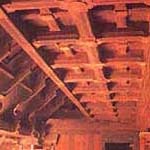
ARCHITECTURAL KERALA
TEMPLE ARCHITECTURE
Temple architecture in Kerala is different from that of other regions in India. Largely dictated by the geography of the region that abounds in forests blessed with bounties of the monsoon, the structure of the temples in Kerala is distinctive.
The roofs are steep and pointed and covered with copper sheets. The shape of the roof is in accordance with the sanctum below.With a circular plan one sees a conical roof while with a square plan the roof is pyramidal.
The central sanctum of a Keralite temple is referred to as the Sree Kovil. It is surrounded by cloisetered Prakara, pierced at one or more cardinal points with Gopuradwara. The cloistered prakaram has a Namaskara Mandapam located directly in front of the sanctum. Prakaram also houses subsidiary shrines. A kitchen is located in the south eastern corner of this cloistered prakaram. The Mugha Mandapam is integrated with the Gopura Entrance. The flag staff or Dwaja Sthambham is located outside the sanctum. The offertory table or Balipeedom may be located in the Mughamandapam or in the outer courtyard.
The Keralite temple is an amalgam of stone work, stucco and painting- harmoniously blended into a structure vibrant with traditions of the region. The wood work here is of great importance, and it gives the essential verve and character to the Kerala temple silhouette. The inner skeletal frame work of the temple is of wood, although the base and the structure above are of granite and laterite respectively. The roof projects out at several levels, in order to protect the inner skeletal frame work from the vigorous monsoons that inundate the region. The temple walls are of coursed, lateritic masonry plastered in mud and lime. Murals are seen on several of these temple walls.

HABITAT ARCHITECTURE
The Nalukettu is the traditional style of habitable architecture of Kerala, wherein a house has a quadrangular courtyard in the centre. Nalukettu is evident in the traditional homes of the upper class homesteads where customs and rituals are a part of life.
These mansions with an open central courtyard by wondrous and intricate architecture using wood for walls and tiles for roofing. The interiors of the house are tastefully decorated with a wealth of antiques made from teak, sandalwood, mahogany etc.
The enclosed courtyard is usually sunk. The protruding roofs of the 'salas' forms shady verandas and protect the rooms from direct sunlight, keeping them cool even on the hottest of days. The inner veranda around the enclosed courtyard is open.
The outer verandas along the four sides of the Nalukettu are enclosed differently. While both the west and east verandas are left open, the north and south verandas are enclosed or semi-enclosed.
